Banana Slug – Geophila Ariondae Ariolimax columbianus
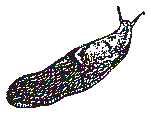 |
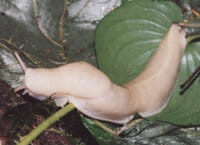 |
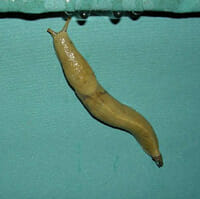 |
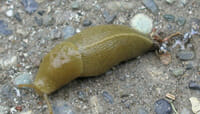 |
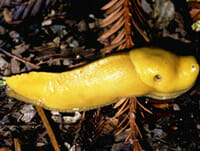 |
Identification & Description:
Banana Slug are Mollusks, which means they are soft-bodied with no visible skeleton. They also belong to the class Gastropoda, which can be recognized by having a muscular foot, a mantle with a cavity, a meaty hump on their back, and a radula (or sand-paper-like grinding mouth parts). They are Pulmonates, which means they have a small lung inside their bodies which opens to the outside with a pneumostone.
The banana slug is the second largest slug in the world, growing up to 25 cm long. On average they range between 6-8 inches, with a life span of 1-7 years. Their coloring is sometimes bright yellow, occasionally with black spots, or solid greenish. Individual slugs will change colors with alterations in food consumption, light exposure, and moisture levels. Color may also indicate whether a slug is healthy, injured, or what age they are. Their coloring allows them to camouflage with leaves and other debris on the forest floor. This serves as protection from such prey as beetles, raccoons, and even other banana slugs. That’s right, these funny critters are tertiary consumers. They are forest floor scavengers that feed on small (already dead) animals, but they are mostly decomposers, feeding on detritus. Banana slugs are considered general herbivores that eat all kinds of leaf litter, green plants and fungus (mushrooms are their favorite foods) and occasionally feed on animal feces and carcass. In the process of debris munching, the A. columbianus disperse seeds and spores while excreting a nitrogen rich fertilize. Slugs, at times are also frugivores and may play a minor role in forest plant regeneration and seed dispersal.
They are named Banana Slugs because very often their coloring resembles a banana, bright yellow body with black spots. Solid greenish, pale brown and even almost white specimens can be found locally too. They can change their color slightly over time, becoming more intense or paler as the light, moisture and food allows. These colors help them to camouflage with the leaves on the forest floor.
They may be confused with an introduced species, the Black Garden Slug, as it is large and also comes in a brownish color. If you look closely at the Garden Slug, you can usually see an orange-striped edging around the foot and textured furrows on all upper parts of the body except the mantle. The Banana Slug does not have any orange on its body and its body is smooth.
The Banana Slug lives in moist forest floors along the Pacific Coast of North America from California to Alaska. It is a decomposer, which means it chews up leaves, and animal droppings and other dead plant material and recycles it into soil. One of their favorite foods seems to be mushrooms. In the process of eating, they also spread seeds and spores.
They can be seen migrating across the path on dark damp days and at night or climbing up stumps looking for a dark place to hide. Once they find a dark damp spot to hide out on dry days, they will usually come back to that same spot, preferring to hide alone. They can fit into amazingly small spaces, this probably helps them to find enclosed areas that are still damp when most others have dried out
With only one muscular foot, a slug moves slowly. How it moves can be seen when you place a slug on a piece of glass and look at it from underneath. Small horizontal waves of muscle move from the back to the front of the animal, allowing it to glide over a surface. A slug can travel over a razor blade or sharp edge of glass without cutting itself because of the slime that covers the foot.
Slime has many functions. One is to keep the slug’s skin moist so it can breathe through it. A slug breathes through its skin and just like the insides of our lungs, the skin must be moist to exchange gases. The slime gathers moisture out of the air like a sponge on damp days and out of the soil under logs on dry days.
A second function of the slime is to protect the slug from predators. They simply hump up their body to make a bigger animal and produce a thick milky mucous. Most animals and birds do not like the slimey texture and the fact that it gets goey-er when it is put in their mouth. Also, when the slime comes in contact with a moist surface, it contains an anasthetic which temporarily causes the membranes to go numb. Raccoons will eat slugs but roll them in dirt first to bind up the slime. Garter snakes, ducks, geese and some salamanders will also eat them too. Baby slugs are eaten by shrews, moles and birds.
Another function of slime is it is used in movement. Slime on the underside of a slug’s body comes in contact with leaves and sticks on the forest floor. This slime coats the leaves, allowing the slug to move over, under and around them easily. A trail of slime is left behind it as it moves along. As well, a slug that has climbed a tree can get down quickly by dropping to the ground safely from a string made of slime.
Slime is useful in mating too. A slug that is ready to find a mate and lay eggs leaves a chemical in the slime to attract other slugs. Another slug smells the chemical and follows the trail to the slug who left it.
Scientists have tried to reproduce slug slime because it is one of the best natural glues and may be of use in the medical field. But somehow, a slug is able to make what no human scientist with years of experience can. Perhaps if they can figure out what component is missing, we will one day have slug sticks instead of glue sticks!
To prevent themselves from drying out during long dry periods, slugs estivate, which is like hibernation except it occurs during hot dry spells. They become inactive, secrete a mucous shield and insulate themselves with a layer of soil and leafy debris.
Slugs are hemaphrodites, which means they contain both male and female organs. A slug that is ready to mate will smell the slime trail left by another slug and follows the trail until it finds it. The slugs exchange sperm and produce 20 or less translucent eggs which is laid under a log or in leaves. Eggs are about half as big as your fingernail on your pinky finger and may be pearly white, pink or even yellowish. Mating and egg laying occurs several times throughout the year. Eggs and young are not protected by the parents.
Slugs use their two pairs of tentacles to sense their environment. The larger pair at the top of their head have a small black spot at each tip that are used to detect light. Slugs cannot see images like we can, but instead rely on brightness or darkness to tell them which direction they should move. They also have a second pair of antennae located at the lower front of the their body. This pair acts like a nose, picking up chemical smells. Both of these tentacles can telecope in and out as they move along the forest floor to protect them from damage when they bump into leaves and twigs.
Sometimes as a slug is moving, you will notice a small hole, usually on its right side, near the front of the body. This hole is called a pneumostone. Air enters the hole and passes into a small lung-like cavity. Like us, when a slug is exercising hard (moving quickly), it needs more oxygen in its body. This extra lung provides more skin area for the slug to breathe through.
Most people think that a slug’s cloaca is located at the back end of the slug, as it is in most animals. This is not true. The lump of material that often gets dragged behind the slug is actually dirt and leafy material which was collected by the slime and gets dropped off at the back end of the slug. The cloaca is located behind the pneumostone under the mantle so it cannot be seen except when the slug is getting rid of wastes.
Banana slugs may live several years, hibernating under a log when the temperature hovers near or below freezing. Scientists do not know exactly how long the average one lives in the wild, however.
Roll over a log (make sure to put it back) or dig through some leaves and pick up a slug to look a little closer. Touch it with a clean index finger, then touch a dry leaf or small twig. The leaf will stick to your finger. You’ll be surprised at how glue-like the slime is! Just like for rubber cement, instead of washing it off, it is better to wave your hand in the air and roll the slime off between your hands or with paper towels. If you try to wash it off, it gets slimier as it gathers water.
It is best to do your slug studies out of doors and leave them where you find them as they make a somewhat slimey animal for classroom studies and should not be kept in a forest floor terrarium unless you are willing to invest the time to clean the slime off the sides of the container. As well, make sure to handle them with clean hands as the salts, natural oils and other contaminants on your hands can damage their skin.
Please do not kill slugs using salt. This is a terrible way to die! The thick goo you see on the slug after salt is put on the body is actually the fluid or blood of a slug that rushes to the skin’s surface to dilute the salt. Dehydration is a nasty way to go. Simply remove the Banana Slug from your garden and place it back in a nearby forest where it can continue its important role as a forest floor decomposer.
Taxonomic Classification:
Kingdom: Animalia
Phylum: Mullusca
Class: Gastropoda
Subclass: Pulmonata
Order: Geophila
Family: Ariondae
Genus: Ariolimax
Species: Ariolimax columbianus
Habitat:
Ariolimax columbianus, commonly known as the banana slug, is endemic to the Pacific Northwest region of North America due to the relative stability and isolation of these areas. They can be found in foggy moist forest habitats of southeast Alaska, British Columbia, Washington, Oregon, and California. They are continuously distributed throughout this region where they seek shelter beneath coastal redwoods and detritus. Within the primarily Mediterranean and Marine West Coast biomes, they remain active most of the year. Banana slugs show arboreal tendencies but are commonly encountered on the ground or within creek banks and tree roots during the dry summer months. They usually partake in nocturnal activity due to their high moisture dependency, but during the cooler rainy winter months they are often seen during the day. They are stenotopic, meaning they have very specific preferences and limited ecological tolerance. Slugs are prone to desiccation, a complete or nearly complete drying out, such as may result in the formation of evaporites from bodies of water in an arid region. At one time banana slugs were blamed for damage done to redwood seedlings. A study later proved that a mutualistic relationship exists between the two. Banana slugs would rather eat cardboard than eat the seedling of a Sequoia sempervirens. Instead, the slugs in the study ate other small plants which are redwood competitors for space, water, light, and nutrients. Rollo and Wellington found that A. columbianus often return to their shelters even if only inhabited for one night. Also, several slugs within their study alternated between to homes possibly displaying home range behavior. It is suggested that this homing behavior is conducive to slug ofactory senses. Slugs often disperse from sparse plant canopies to adjacent dense vegetation, but often will occupy less dense habitats to avoid competitors.
Natural History:
Ariolimax columbianus begin their lives as 15-20 mm colorless eggs deposited by their hermaphroditic parent(s) who usually cross fertilize, ideally where ground water and humidity are high. They are usually deposited in clumps of 30 eggs that will hatch in 3-8 weeks. In order to hatch, the eggs need sustained moisture, mild temperatures, and a good hiding place. Once the eggs have hatched, it is up to the baby banana slugs to find their own food for survival. Predators like to eat banana slugs at all stages of their lives. A high number of eggs hopefully ensures the survival of the species, even though they have a high mortality rate. Banana slugs have a high growth rate, which also helps to maintain a stable population. Ariolimax columbianus are diurnal during late March to early July, then from late August to early November feeding mostly above ground on vegetation and sleeping on shrubs and trees at night.
When compared to other invertebrates, the life history characteristic of A. columbianus are strongly K-selected and probably evolved through intraspecific exploitative competition within predictable and stable forest habitats. This means that they compete between other individuals of the same species (Ariolimax columbianus), depleting the same resources without directly interacting, except when mating. Banana slugs tend to be loners who survive below the protective Western and Mountain hemlocks, coastal Redwoods, and Giant Sequoias of the Sierra Nevada west-face, as well as other various coniferous species. Hamilton and Wellington found Ariolimax columbianus mortality to be severely affected by population density which may be due to their non-aggressive tendencies. They also concluded that banana slugs are able to endure longer periods of intense weather as compared to the Arion ater slug. They attribute this to the large surface area to volume ratio which causes less evaporative stress.
Distribution:
Limiting abiotic factors such as moisture, temperature, and the need for heavy ground cover make the forest habitats of the west coast the perfect homes for the terrestrial slugs. The Ariolimax columbianus are most likely paleoendemics restricted to a range that extends as far north as Sitka, Alaska, to the west side of the Cascade range in British Columbia, on the west coast of Washington and Oregon, and finally into California, primarily on the coast and as far south as Salinas Valley. In 1992, The Veliger reported the first documented siting of A. columbianus in Plumas County, California on the western slopes of the Sierra Nevada’s. This is also the highest elevation (1,097 meters) the banana slugs have ever been documented at. A biotic factor that restricts the distribution range of the banana slug has been studied by Mark Denny who attributes their high cost of mucus (slime) locomotion. Two disadvantages of adhesive crawling of gastropods, according to Denny are that the adhesive power of the slime must be overcome by the animal, and that the mucus must be produced to replace the expended slime during movement. These factors limit the distance to which slugs will crawl in search of food or mates. Banana slug slime also serves as defense from predators, helps them retain moisture, reproduce, and may also serve as nutrition if necessary.
Interesting information:
– A temporary commenalism relationship may exist between the sow bug, Porcellio scaber, and the banana slug during dry, hot weather. The banana slug provides additional moisture that the sow bug needs.
– SLUGS LOVE TO EAT strawberries, lettuce, lillies, mushrooms, and poison oak.
– SLUGS AVOID EATING juniper, ivy, baby’s tears, and bleeding hearts.